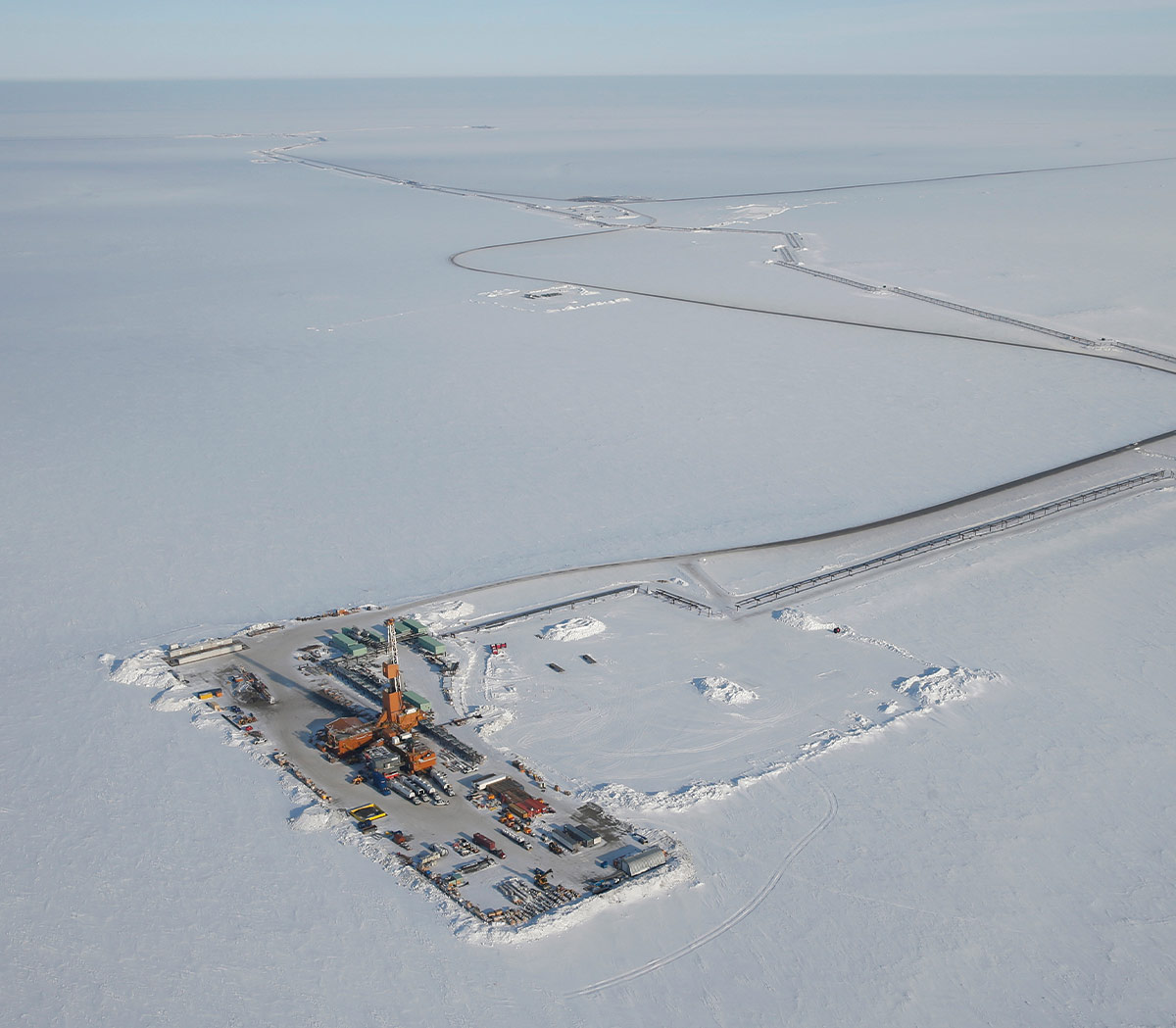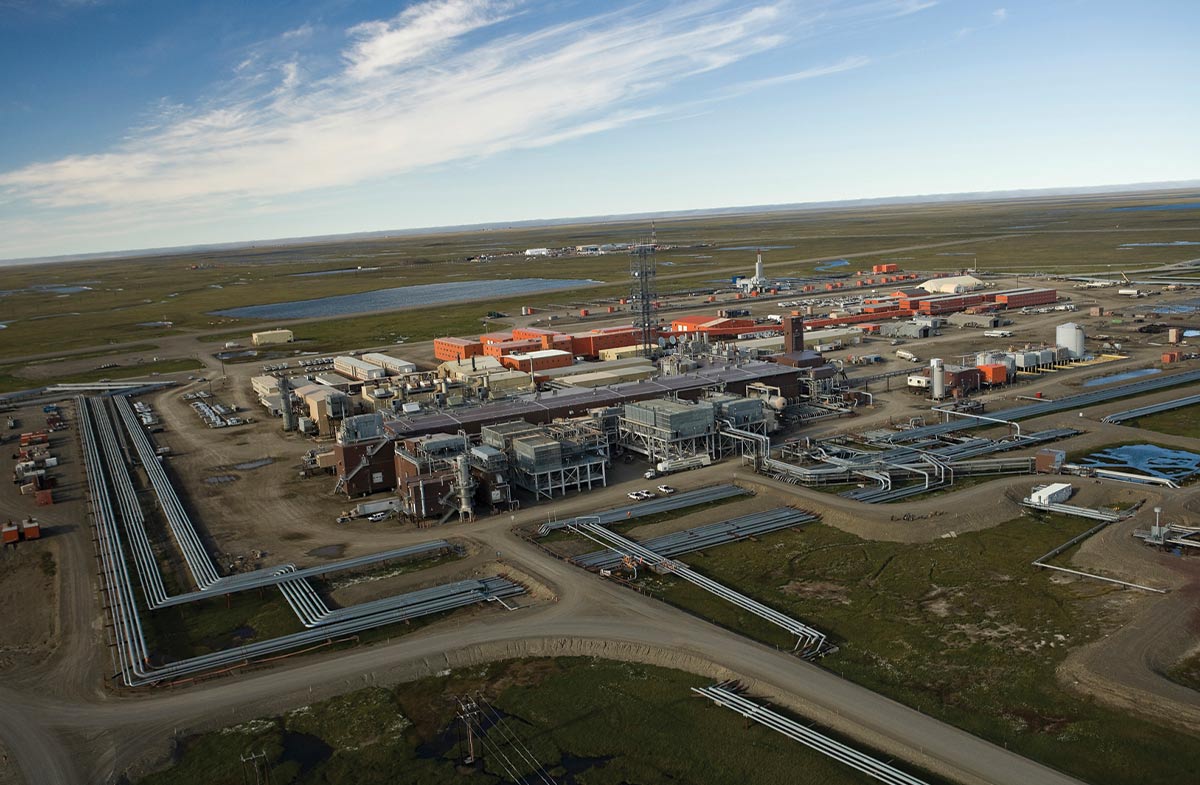onocoPhillips is one of Alaska’s most established oil development companies and its largest producer. The oil giant owns approximately 1.3 million net undeveloped acres on the North Slope, holds major ownership interests in Kuparuk and Prudhoe Bay, a 100 percent ownership interest in the Alpine field, and has an extensive inventory of development projects that include Eastern NEWS in the Kuparuk Field, Narwhal in the Western North Slope, and the Nuna discovery east of the Colville River.
Alongside that is what Nick Olds, senior vice president of global operations, called the company’s “bread-and-butter development work” at an investor presentation in June, including the recently discovered Coyote trend at Kuparuk and the company’s extended-reach drilling program in the Western North Slope.
But the company’s size and dominance in Alaska weren’t enough to inoculate it from the effects of the COVID-19 pandemic, which last April forced ConocoPhillips to end its exploration and development projects in Alaska earlier than scheduled, remove workers from the North Slope, and bring operations down to critical function only.
“[Last year] was obviously a difficult year for society, a difficult year for our industry, a difficult year for the economy, and all the social aspects associated with the economy,” ConocoPhillips Alaska President Erec Isaacson told attendees at the Resource Development Council’s annual membership luncheon in June. “As we entered 2021, our focus was on safety and protecting our base assets, maintaining production, and minimizing decline.”
That makes 2021 a “reset” year for the company, he added, one that so far seems to be working. Production for ConocoPhillips during the first quarter of 2021 was approximately 208,000 barrels of oil equivalent per day, with an average price of $60 per barrel and continuing to rise, Isaacson said.
That promising start, coupled with the company’s numerous long-term opportunities, including Greater Moose’s Tooth 1 and 2, the Alpine expansion and turnaround, and the Willow Development, makes ConocoPhillips Alaska poised to remain a competitive asset in the global oil and gas industry.
The oil and gas industry suffered collateral damage when the pandemic sent—and kept—the world indoors last year. According to the US Travel Association, spending on international, domestic, and business travel declined 42 percent from 2019, creating a domino effect: lack of travel meant a decline in the demand for oil, which in turn caused the price of oil to plummet to record lows. Those reductions, combined with efforts to mitigate the spread of COVID-19 amongst its workforces, created massive disruptions to ConocoPhillips Alaska’s operations.
“That reduction in demand, it led to curtailments. It led to proration on the pipeline, and because of the reduction in capital spending and the reduction in demand, what we had to do was de-man all of our rigs on the North Slope,” Isaacson said in June. “We had to curtail our exploration season early in the middle of our activity there because we didn’t know how the pandemic was going to impact our operations on the North Slope.”
As 2020 drew to a close, several events coalesced to indicate a slow return to something resembling normal. The November defeat of Ballot Measure 1, implementation of a robust COVID-19 testing program, and the looming availability of vaccinations allowed ConocoPhillips to restart operations last December, with Doyon 25 resuming drilling activities at CD5 in Alpine.
The company began working to bring all of its assets back online in the spring and summer, an incremental process that began with production, and operations then moved on to development and exploration with its rigs, Isaacson says. Doyon 25 moved from Alpine to GMT-2 to complete drilling in anticipation of its projected fourth-quarter completion date; at max production, GMT-2 will provide an additional 35,000 barrels of oil per day, Isaacson said.
Doyon 26, the extended reach drilling rig known as “The Beast,” also began drilling at the Fiord West Kuparuk development at Alpine in the spring, and in July the company was working to install a slug catcher and expand the facility’s power and natural gas-handling capabilities.
The company’s reset also includes “working as an organization to become more nimble, to become more efficient, to become more effective, to bring our costs down,” Isaacson said in June, which is necessary to ensure Alaska remains competitive when it comes to capital investment.
Located 30 miles from the Alpine Central Facility in the Northeast portion of the National Petroleum Reserve–Alaska (NPR-A), Willow was a significant discovery in 2017. With an expected peak production of more than 160,000 barrels of oil per day, the North Slope hasn’t had a project of Willow’s size and scope since the Alpine development in the late 1990s.
ConocoPhillips
ConocoPhillips

“Willow is truly a significant discovered resource opportunity that we have on the Slope,” Isaacson said at the RDC luncheon. “It leverages existing infrastructure with regard to the pipeline network and the infrastructure that’s already established on the North Slope.”
In October 2020 the US Department of the Interior, Bureau of Land Management authorized construction of up to three drill sites, as well as the necessary processing and support facilities, which would include gravel roads and pipelines to permit access to federal leases. But two federal lawsuits, an injunction that put a stop to construction, and a new administration in the White House almost immediately put the project in jeopardy.
However, those concerns were predominantly put to rest in May.
“The Biden Administration’s decision to allow Willow to move ahead proves how thorough the permitting process is for Alaska projects,” said Kara Moriarty, president and CEO of the Alaska Oil and Gas Industry. “Clearly, the many hurdles cleared were done so properly and followed a prescribed process that demands strict environmental protections. We often hear about the need for resource development to ‘follow the science’ and absolutely agree this decision reflects a commitment to solid research, data, and facts.”
For industry insiders, the administration’s decision to intervene wasn’t viewed as a surprise. Instead, it was the logical outcome of a strong educational and advocacy campaign.
“I think [the intervention] really underscores all of the effort that was put out there by the federal delegation, by the State of Alaska, by the North Slope Borough, by the Native communities, by the trade associations, as well as the unions, on the importance of the Willow project for the State of Alaska, in regard to future income and future economic stability,” Isaacson says. “And because of all of that outreach and education that went out to the new administration, we didn’t really see it as too surprising.”
Isaacson wouldn’t speculate on the outcome of the pending lawsuits but says ConocoPhillips is moving forward with front-end engineering design so that it can make a final investment decision by the end of the year if the resolution is favorable.
Based on the company’s timeline, Olds told investors in June that first oil, estimated to require approximately $6 billion in capital to reach, is expected six years after a final investment decision is made. Development of the field will require drilling 200 wells from the three approved drill sites, he added.
ConocoPhillips’ 2021 reset and the forward progress on Willow is a boost not only to ConocoPhillips but to Alaska’s economy as well, providing an infusion of capital and both short- and long-term jobs. Those opportunities are a welcome respite for the industry, which watched as COVID-19 derailed the gains made following the economic downturn of 2015 to 2018.
“The back-to-back losses of 2015 to 2018 and then COVID and the decline in oil production have really taken a toll on the support industry,” says Rebecca Logan, CEO of the Alaska Support Industry Alliance. “I’ve been working here for twelve years and we’re at the lowest numbers we’ve ever been at it. We were at 16,000 members when I started: now we’re down to about 6,900 members. So, it’s devastating.”
The Willow project will alleviate some of those losses. The construction phase is estimated to provide more than 2,000 jobs over multiple years, the equivalent of 9 million man-hours to get it to the point where it’s ready to produce, Isaacson said in June. Once producing, it will provide 300 permanent positions, he added.
“We’re all feeling good about Willow right now,” Logan says of the support industry’s reaction to the Biden administration’s intervention. “That is a lot of jobs for our members.”
The project also benefits Alaska in terms of actual dollars being paid to federal, state, and local governments. The Bureau of Land Management estimates that Willow will bring more than $10 billion in financial benefits, more than half of which will flow directly to Alaska.
“If you break that [$10 billion] down to its components, it’s $2.4 billion to the State of Alaska, $1.2 billion to the North Slope Borough in property taxes, [and] $2.6 billion goes to the impacted communities through the NPR-A Impact Mitigation Grants,” Isaacson said in June. “So, that’s a significant benefit to the State of Alaska.”
But Willow isn’t the only ConocoPhillips project putting Alaskans to work. In 2020 the company employed approximately 700 people at its GMT-2 facility, and already this spring and summer it had 500 workers employed at Alpine to expand the facility’s power and gas handling capabilities, Isaacson said.
ConocoPhillips Alaska also hit reset in 2021 with the appointment of Isaacson as its newest president in January. Isaacson began his career with ConocoPhillips in 1986 when it was still Phillips Petroleum Company, but he is no stranger to Alaska—from 2006 to 2010, he spent time in the state first as manager for the company’s Alaska explorations and later as vice president of commercial assets, with accountability for non-operated, pipeline, and Cook Inlet assets.
His initial focus as head of the Alaska division is to get the company’s operations back up and running.
ConocoPhillips
ConocoPhillips

“The focus this year is ramping that organization back up after COVID,” he says. “It’s getting those rigs out there and being efficient in the field. That’s a big part of this year’s effort, is really kind of getting the organization back in that execution [phase].”
He’s also jumped into working alongside industry partners to advocate not just for ConocoPhillips’ interests, but for the importance of the oil and gas industry to Alaska’s economy.
“I think Erec is a great addition to the team here at ConocoPhillips, and our members have worked together so well—obviously on the Willow project, but also on advocacy work in the State of Alaska,” Logan says. “There’s just been a really strong partnership there, and I see that Erec plans to continue with that and really rely on the trade associations and advocating for the industry.”
Long-term, Isaacson says his focus is on keeping Alaska competitive.
“As I take a look at what I’m focusing on with my organization, it’s working to simplify our operations and reduce costs in our operations,” he says. “And then, working with our stakeholders in emphasizing that need to be competitive, to warrant additional capital to keep the industry strong on the North Slope.”
The failure of Ballot Measure 1 was an important step in that process, and with a stable fiscal regime, Isaacson says Alaska can remain competitive in the company’s overall global portfolio and continue to attract investment for new projects, which is vital to stemming the decline of existing North Slope fields.
“There are headwinds that could prevent some of these opportunities, but I’m optimistic that at the end of the day, the outcomes can be achieved that can keep the oil and gas industry in Alaska in the game,” he said. ![]()